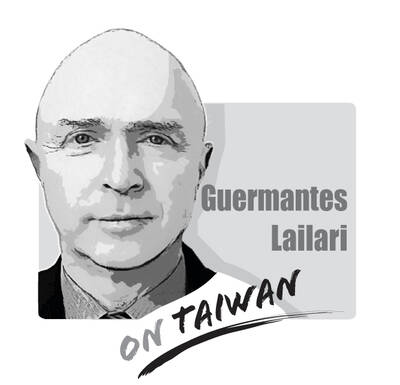Russia’s invasion of Ukraine has been going on for nearly a year and a half. At the end of last year Ukraine started building the world’s first “naval fleet of drones” to counter Russia’s Black Sea fleet, news reports said. One of Ukraine’s maritime drones — an uncrewed surface vessel (USV) that resembles a speedboat — is 5.5m long and weighs one tonne. It has an operational radius of up to 400km and can operate autonomously for up to 60 hours. It can carry a combat load of up to 200kg and has a maximum speed of 80kph. The USV’s main functions include long-range maritime reconnaissance and coastal surveillance, escorting and supporting Ukraine’s conventional fleet and countering amphibious operations, among others. This Ukrainian-developed USV is believed to be the weapon that badly damaged the Kerch Bridge in Crimea on July 17, effectively blocking Russia’s logistical supply line, and had attacked the Crimean Black Sea port of Sevastopol the previous day.
Taiwan would do well to learn from this experience. To be ready for a war across the Taiwan Strait, the nation should develop a sea-drone fleet that is maneuverable, fast, cheap and effective. In recent years there have been several incidents of Chinese illegally crossing over to Taiwan on simple rubber dinghies. As well as favorable sea conditions and good luck, another reason they managed to reach Taiwanese territory is that a dinghy’s low profile on the sea surface makes it hard to detect using electronic devices. For the same reason, USVs have a “stealth” function. Despite their small size, they can be used to hit ships of the People’s Liberation Army Navy as they try to cross the Taiwan Strait, thus giving Taiwan a chance to win decisively outside its own territory.
Taiwan also needs to develop a system that can launch sea-to-air or sea-to-ground missiles from USVs. If China were to invade Taiwan, the first attack waves would destroy more than half of Taiwan’s military airfields, warships, naval harbors and missile bases, as well as a large number of the military personnel stationed at those sites. In such a scenario, easily concealed sea drones and their operators stationed in bunkers might well play a role in turning the tide of the war.
Fang Fu-chuan is an international trader.
Translated by Julian Clegg

George Santayana wrote: “Those who cannot remember the past are condemned to repeat it.” This article will help readers avoid repeating mistakes by examining four examples from the civil war between the Chinese Communist Party (CCP) forces and the Republic of China (ROC) forces that involved two city sieges and two island invasions. The city sieges compared are Changchun (May to October 1948) and Beiping (November 1948 to January 1949, renamed Beijing after its capture), and attempts to invade Kinmen (October 1949) and Hainan (April 1950). Comparing and contrasting these examples, we can learn how Taiwan may prevent a war with
A recent trio of opinion articles in this newspaper reflects the growing anxiety surrounding Washington’s reported request for Taiwan to shift up to 50 percent of its semiconductor production abroad — a process likely to take 10 years, even under the most serious and coordinated effort. Simon H. Tang (湯先鈍) issued a sharp warning (“US trade threatens silicon shield,” Oct. 4, page 8), calling the move a threat to Taiwan’s “silicon shield,” which he argues deters aggression by making Taiwan indispensable. On the same day, Hsiao Hsi-huei (蕭錫惠) (“Responding to US semiconductor policy shift,” Oct. 4, page 8) focused on
Taiwan is rapidly accelerating toward becoming a “super-aged society” — moving at one of the fastest rates globally — with the proportion of elderly people in the population sharply rising. While the demographic shift of “fewer births than deaths” is no longer an anomaly, the nation’s legal framework and social customs appear stuck in the last century. Without adjustments, incidents like last month’s viral kicking incident on the Taipei MRT involving a 73-year-old woman would continue to proliferate, sowing seeds of generational distrust and conflict. The Senior Citizens Welfare Act (老人福利法), originally enacted in 1980 and revised multiple times, positions older
Nvidia Corp’s plan to build its new headquarters at the Beitou Shilin Science Park’s T17 and T18 plots has stalled over a land rights dispute, prompting the Taipei City Government to propose the T12 plot as an alternative. The city government has also increased pressure on Shin Kong Life Insurance Co, which holds the development rights for the T17 and T18 plots. The proposal is the latest by the city government over the past few months — and part of an ongoing negotiation strategy between the two sides. Whether Shin Kong Life Insurance backs down might be the key factor